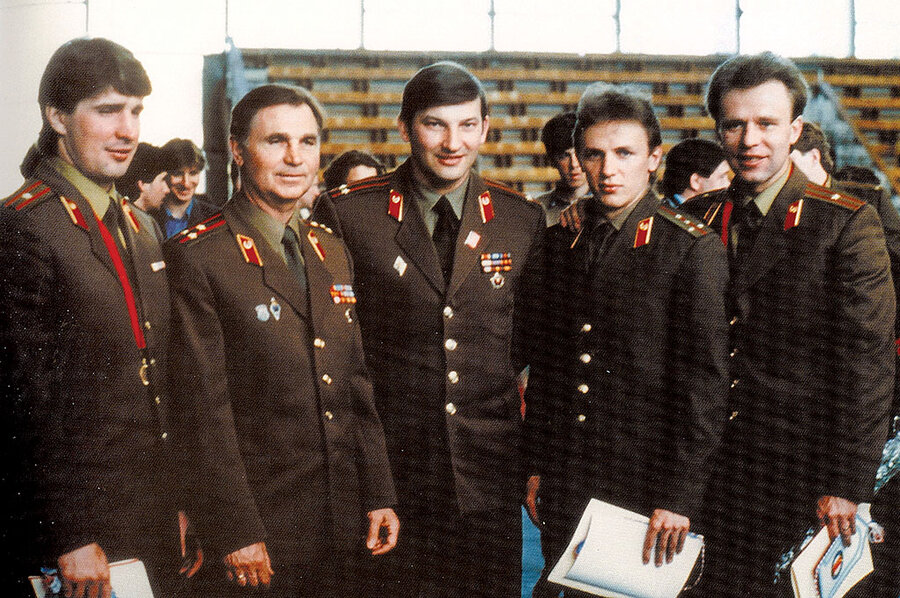'Red Army' is a lively documentary about the famous Soviet hockey team
Loading...
Three things the Russians take very seriously – ballet, chess, and hockey. “Red Army,” Gabe Polsky’s lively documentary about the famous Soviet hockey team of the 1970s and ’80s, is, in a sense, about all three. The team known as the Red Army combined balletic grace with chesslike strategy on the ice. Most hockey aficionados consider them to be the greatest squadron of all time.
Polsky, whose parents were Soviet Ukrainian immigrants and who himself played hockey for Yale, centers his film on Vyacheslav “Slava” Fetisov, who, prior to the USSR’s collapse, was the most celebrated hockey player in Russia. We see Fetisov, as well as many other players and participants, in archival footage from the Red Army’s heyday, but at the core of the film are contemporary interviews with him as he warily, grudgingly, sometimes nakedly responds to Polsky’s persistent questioning.
Big and burly, at times seemingly epoxied to his cellphone, Fetisov often waves away Polsky’s entreaties as if his interviewer were a particularly pesky gnat. But Fetisov is enough of a showman to cultivate his persona; he enjoys playing the heavy to Polsky’s bantamweight. And when he recounts incidents that still sting for him, he doesn’t hold back. Fetisov may be something of a enigma, but when it matters most to him, he opens his heart wide.
The Red Army was a propaganda weapon for the Soviets, a way of demonstrating, through victory, that their way of life was far superior to the West’s decadence. This is why, when the US hockey team upset the Red Army on the way to the gold in the 1980 Lake Placid Winter Olympics – dramatized by Hollywood in the 2004 Kurt Russell movie “Miracle” – it was more than a loss for the Russians. It was a political debacle. (The closest equivalent would be Boris Spassky’s 1972 world chess championship loss to Bobby Fischer, a match that was also promoted beforehand, by both sides, as a validation of national superiority.)
Fetisov rolls his eyes at the Lake Placid blip in an otherwise near-perfect Red Army record. (The team won gold in the two subsequent Winter Olympics.) The real sore point for him is how he and his teammates, in a grueling year-round regimen, were required by the Soviet authorities to live and train for months apart from their families as soon as the team was taken over by the KGB’s Viktor Tikhonov, who was temperamentally poles apart from his ousted predecessor, Anatoly Tarasov, a bulbous, companionable coach who studied the Bolshoi Ballet for insights into hockey moves.
When the Soviet Union began to come apart in the early 1990s, Fetisov and many of the most talented Russian players went to the dreaded West to play in the National Hockey League only to discover that the style of play there was anything but balletic.
Deprived of their precision teamwork, the players were for a time hampered on the ice and redbaited by the fans. (Most of the Russians did not defect but were required to pay the bulk of their large salaries back to Russia – another sore point for Fetisov, not so much because of any nascent materialism but because it made him feel like a serf.) In time the Red Army was virtually reconstituted when a number of them joined the Detroit Red Wings. The result: back-to-back Stanley Cups. This time the fans cheered them on. Victory turns a blind eye to ideology every time.
Audiences knowing nothing about hockey will still be able to appreciate this movie as a somewhat jaunty take on the cold war and its aftermath – and resurgence. A curious kind of cold-war nostalgia can be felt in the West these days; President Vladimir Putin is the kind of comprehensible villain Americans feel comfortable with.
Viewed in this light, Fetisov is more than ever a complicated – and in some ways weirdly emblematic – national symbol. In his heyday he rebelled against how the Russian authorities exploited him, yet he never once contemplated defection. Now, as a former minister of sports and a member of the National Assembly, he is a member of Mr. Putin’s inner circle. Just how thin is the ice upon which he now skates? Grade: B+ (Rated PG for thematic material and language.)





